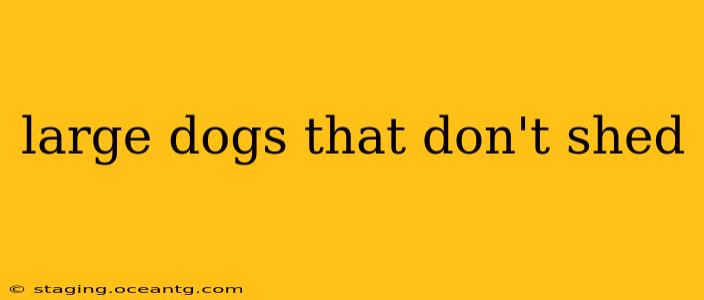Finding a large dog that doesn't shed might seem like searching for a unicorn, but several breeds come close! While no dog is truly "non-shedding," some shed minimally and are often considered hypoallergenic. This guide explores breeds that fit this description, addressing common questions and concerns. Remember, even these low-shedding breeds require regular grooming to maintain their coats and minimize any shedding.
What Makes a Dog "Hypoallergenic"?
Before diving into breeds, it's crucial to understand what "hypoallergenic" means. It doesn't mean a dog won't cause any allergic reactions. The allergen in dog dander isn't the hair itself, but proteins in the dog's saliva and skin. Hypoallergenic dogs produce less of these proteins or have different coat structures that trap them better. This reduces the amount of allergens in the environment, making them more suitable for people with allergies. However, individual reactions vary.
Large Dog Breeds That Shed Minimally
Several large breeds are known for their relatively low shedding. These include:
1. Portuguese Water Dog:
Known for their famously curly coat, Portuguese Water Dogs are a popular choice for those seeking a large, low-shedding companion. Their coat requires regular grooming, including professional haircuts, to prevent matting and keep shedding to a minimum. Regular brushing is also essential.
2. Standard Poodle:
The elegant Standard Poodle is another excellent option. Their curly coat traps dander effectively, leading to less shedding than many other breeds. Regular grooming is vital to keep their coat healthy and prevent matting, which can lead to more shedding.
3. Irish Water Spaniel:
Despite the name suggesting otherwise, the Irish Water Spaniel possesses a uniquely wiry coat that sheds relatively little. Their coat needs regular professional grooming to avoid matting and keep shedding under control.
4. Giant Schnauzer:
The Giant Schnauzer's wiry coat sheds minimally, making it a surprisingly good choice for those sensitive to dog hair. Regular grooming, particularly hand-stripping or professional clipping, is crucial for maintaining the coat's health and reducing shedding.
Are There Any Other Factors to Consider?
Yes, beyond the breed itself, several factors influence a dog's shedding:
What is the Difference Between Shedding and Molting?
While often used interchangeably, shedding and molting are distinct processes. Shedding is a continuous process of hair loss, happening daily. Molting, on the other hand, is seasonal, involving a significant shedding of the undercoat to prepare for warmer or colder weather. Even low-shedding dogs will molt.
How Often Should I Groom My Dog?
Regular grooming is essential for all dogs, especially low-shedding breeds. Professional grooming every few weeks, combined with daily brushing at home, can significantly reduce shedding and maintain a healthy coat.
What is the Best Way to Minimize Shedding?
Besides regular grooming, providing a balanced diet and ensuring your dog has a healthy lifestyle can impact shedding levels. Consult with your vet if you notice excessive shedding, as it could indicate an underlying health issue.
Finding the Right Large, Low-Shedding Dog for You
Selecting a large, low-shedding dog involves careful consideration. Breed temperament, exercise needs, and grooming requirements must be factored into your decision. Researching different breeds thoroughly before adopting is crucial to ensure a happy and healthy relationship with your furry companion. Remember to spend time with the dog before adopting to assess their personality and compatibility with your lifestyle.
Disclaimer:
This information is intended for general knowledge and informational purposes only, and does not constitute medical or veterinary advice. Always consult with a professional veterinarian for any health concerns or before making any decisions related to your pet's health or well-being.
